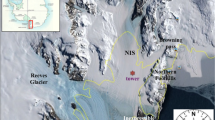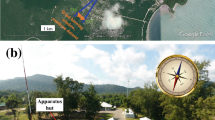Abstract
The interpretation of ultra-high resolution radar observations of thin clear-air echo strata is made with the aid of fine-scale aircraft measurements. The echo layer, generally comprising two sub-strata each 5 m thick and spaced 7–10 m apart, is found within a 10–20 m deep section of a strong inversion where the thermal stability and shear are maximized, and the Richardson number is close to 0.25. Mechanical turbulence is restricted entirely to this layer; the variance of the N-S velocity component, σν 3, is the strongest, consistent with the orientation of the shear vector in this stratum. Spectra and cospectra of a 9-s slant run through the echo stratum show remarkably ordered motions. A strong negative peak of <νw> covariance at 80-m scale, accompanied by a zero of <uw> covariance and bulges in the longitudinal (ν) and vertical (w) velocity spectra, is identified with breaking Kelvin-Helmholtz waves oriented in the N-S direction along the shear vector. A synthesis of the temperature and velocity structures from measurements along the flight path confirms the ordered motion deduced from the spectra and reveals a group of K-H waves of 80-m length and 10-m height at the height of the radar echo. Microscale K-H ripples of 3–4 m length are also deduced to be present in the 0.5 m thick interfacial region where the thermal gradient and shear are strongly enhanced by the larger shearing K-H wave.
Two possible sources of the echoes are proposed: (1) scatter from fully developed turbulence within the interfacial zone in an inertial subrange falling entirely in sub-meter scales; and (2) the incoherent summation of specular reflections from properly oriented portions of the microscale K-H ripples. While the authors favor the first of these mechanisms, both require stringent conditions of the physical microstructure which are beyond the available observations. Fossil turbulence is precluded as an echo mechanism.
Similar content being viewed by others
References
Atlas, D.: 1964, ‘Advances in Radar Meteorology’, inAdvances in Geophysics 10, Academic Press, New York, 317–478.
Atlas, D., and Metcalf, J. I.: 1970, ‘The Amplitude and Energy of Breaking Kelvin-Helmholtz Waves and Turbulence’, Technical Report No. 19, Laboratory for Atmospheric Probing, The University of Chicago.
Atlas, D., Hardy, K. R., and Naito, K.: 1966, ‘Optimizing the Radar Detection of Clear Air Turbulence’,J. Appl. Meteorol. 5, 450–460.
Atlas, D., Richter, J. H., and Gossard, E. E.: 1969, ‘Waves, Turbulence, and Insects as Seen by Ultra High Resolution Radar, Technical Report No. 13, Laboratory for Atmospheric Probing, The University of Chicago.
Atlas, D., Metcalf, J. I., Richter, J. H., and Gossard, E. E.: 1970, ‘The Birth of ‘CAT’ and Microscale Turbulence’,J. Atmos. Sci. 27, 903–913.
Batchelor, G. K.: 1967,The Theory of Homogeneous Turbulence, Cambridge University Press.
Bean, B. R., McGavin, R. E., Chadwick, R. B., and Warner, B. D.: 1971, ‘Preliminary Results of Utilizing the High Resolution FM Radar as a Boundary-Layer Probe’,Boundary-Layer Meteorol. 1, 466–473.
Browning, K. A., Harrold, T. W., and Starr, J. R.: 1970, ‘Richardson Number Limited Shear Zones in the Free Atmosphere’. Quart. J. Roy. Meteorol. Soc.96, 40–49.
Dutton, J. A.: 1969, ‘An Energy Budget for a Layer of Stratospheric CAT’, Radio Sci.4, 1137–1142.
Fukushima, M. and Iriye, H.: 1966, ‘Observation of Small-Scale Irregularities of the Radio Refractive Index in the Lower Troposphere’, J. Radio Res. Labs. (Japan)13, 201–210.
Gossard, E. E., Richter, J. H., and Atlas, D.: 1970, ‘Internal Waves in the Atmosphere from HighResolution Radar Measurements’, J. Geophys. Res.75, 3523–3536.
Gossard, E. E., Jensen, D. R., and Richter, J. H.: 1971, ‘An Analytical Study of Tropospheric Structure as Seen by High-Resolution Radar’, J. Atmos. Sci.28, 794–807.
Hall, J. M. and Pao, Yih-Ho: 1969, ‘Spectra of Internal Waves and Turbulence in Stratified Fluids, 2, Experiments on the Breaking of Internal Waves in a Two-Fluid System’,Radio Sci. 4, 1321–1325.
Hardy, K. R. and Katz, I.: 1969, ‘Probing the Clear Atmosphere with High Power, High Resolution Radars’,Proc. IEEE 57, 468–480.
Kelly, R. E., and Maslowe, S. A.: 1970, ‘The Non-Linear Critical Layer in a Slightly Stratified Shear Flow’,Stud. Appl. Math. 49, 301–326.
Kropfli, R. A., Katz, I., Konrad, T. G., and Dobson, E. B.: 1968, ‘Simultaneous Radar Reflectivity Measurements and Refractive Index Spectra in the Clear Atmosphere’,Radio Sci. 3, 991–994.
LaGrone, A. H. and Deam, A. P.: 1971, ‘Simultaneous Observations of Disturbed Clear Air Regions with Radar, Pibal, and Instrumented Aircraft’, Report No. P-46, Antennas and Propagation Laboratory, The University of Texas at Austin.
Lane, J. A.: 1968, ‘Small-Scale Variations of Radio Refractive Index in the Troposphere. Part 1: Relationship to Meteorological Conditions’,Proc. IEE (London) 115, 1227–1234.
Lenschow, D. H.: 1972, ‘The Measurement of Air Velocity and Temperature Using the NCAR Buffalo Measuring System’, Technical Note EDD-74, National Center for Atmospheric Research, Boulder, Colo., U.S.A.
McAllister, L. G., Pollard, J. R., Mahoney, A. R., and Shaw, P. J. R.: 1969, ‘Acoustic Sounding — A New Approach to the Study of Atmospheric Structure‘,Proc. IEEE 57, 579–587.
Metcalf, J.I. and Atlas, D.: 1972, ‘Microscale Ordered Motions and Atmospheric Structure Associated with Thin Echo Layers in Stably Stratified Zones’, Technical Report No. 28, Laboratory for Atmospheric Probing, The University of Chicago.
Ottersten, H.: 1969, ‘Atmospheric Structure and Radar Backscattering in Clear Air’,Radio Sci. 4, 1179–1193.
Richter, J. H.: 1969, ‘High Resolution Tropospheric Radar Sounding’,Radio Sci. 4, 1261–1268.
Scorer, R. S.: 1969a, ‘Billow Mechanics’,Radio Sci. 4, 1299–1308.
Scorer, R. S.: 1969b, ‘Mechanisms of Clear Air Turbulence’, inClear Air Turbulence and Its Detection (ed. by Y. H. Pao and A. Goldburg), Plenum Press, New York, pp. 34–50.
Stratmann, E., Atlas, D., Richter, J. H., and Jensen, D. R.: 1971, ‘Sensitivity Calibration of a Dual Beam Vertically Pointing FM-CW Radar’,J. Appl. Meteorol. 10, 1260–1265.
Stratmann, E. and Metcalf, J. I.: 1971, ‘Digital Processing of FM-CW Radar Data’, Technical Note No. 6, Laboratory for Atmospheric Probing, The University of Chicago.
Tatarski, V. I.: 1960, ‘Radiophysical Methods for the Investigation of Turbulence’,Radiofizika 3, 551–583.
Tatarski, V. I.: 1961,Wave Propagation in a Turbulent Medium, (transl. by R. A. Silverman), McGrawHill, New York, 285 pp.
Tennekes, H. and Lumley, J. L.: 1972,A First Course in Turbulence, MIT Press, Cambridge, Massachusetts.
Thorpe, S. A.: 1969, ‘Experiments on the Stability of Stratified Shear Flows’,Radio Sci. 4,1327–1332.
Woods, J. D.: 1969, ‘On Richardson's Number as a Criterion for Laminar-Turbulent-Laminar Transition in the Ocean and Atmosphere’,Radio Sci. 4, 1289–1298.
Woods, J. D. (ed), Högström, V., Misme, P., Ottersen, H., and Phillips, O. M.: 1969, ‘Fossil Turbulence’, Radio Sci. 4, 1365–1367.
Author information
Authors and Affiliations
Additional information
This paper is based in part on the doctoral dissertation by the senior author.
Present affiliation: Air Force Cambridge Research Laboratories, Bedford, Mass., U.S.A.
Rights and permissions
About this article
Cite this article
Metcalf, J.I., Atlas, D. Microscale ordered motions and atmospheric structure associated with thin echo layers in stably stratified zones. Boundary-Layer Meteorol 4, 7–35 (1973). https://doi.org/10.1007/BF02265223
Received:
Issue Date:
DOI: https://doi.org/10.1007/BF02265223




